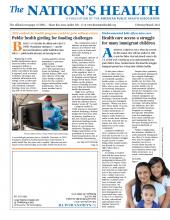
Julie Swain, RN, hugs Jelani Waheed at a violence intervention program at Boston Medical Center in 2018. Swain helped care for Waheed when he was a victim of street violence.
Photo by Craig F. Walker, courtesy The Boston Globe/Getty Images
Gun violence is an escalating problem in many American cities and states. And while community violence intervention programs have had success, creating stable funding for them has been difficult.
Recently, an alternative funding mechanism has been embraced by seven states: Medicaid reimbursement.
As gun violence increased during the COVID-19 pandemic, and Congress failed to act on gun regulation, the Biden administration in 2021 made it easier for states to use Medicaid funds to invest in violence prevention.
Medicaid offers flexibility that allows states to tie Medicaid funding to needs of the community, including violence prevention.
California, Colorado, Connecticut, Illinois, Maryland, New York and Oregon have passed legislation allowing Medicaid to reimburse services involved in violence prevention. States can also implement Medicaid reimbursement without new legislation through various benefit services and waiver programs. And federal dollars will match state Medicaid dollars.
“When we’re addressing community violence, and we’re thinking about things like Medicaid, this is an area that (politicians) can come together on and avoid some of those political debates regarding the Second Amendment,” Kyle Fischer, MD, MPH, policy director for the Health Alliance for Violence Intervention, told The Nation’s Health.
Medicaid funding for violence prevention is “about people and how to take care of the health of our population,” he said.
Many violence prevention programs are financed through grants and philanthropy, both unstable sources. In response to rising gun violence, the Bipartisan Safer Communities Act was passed in summer 2022, offering $250 million over five years toward violence intervention, and local and state governments have earmarked hundreds of millions of dollars for violence prevention through the American Rescue Plan. And while these windfalls have been transformative, they remain one-time cash infusions.
Violence intervention programs successful
Two leading public health approaches toward violence are hospital-based interventions and street outreach, both targeting young people who are victims of or at risk for gun violence.
Hospital-based violence intervention programs strive to reduce violent injury through trained professionals with lived experience who gain the trust of high-risk patients treated in hospitals. The tactic is aimed at lowering recidivism. Patients take part in social, psychological and health services that address upstream factors that contribute to gun violence.
Over 50 U.S. hospitals partner with violence prevention programs. Research shows that hospital-based interventions work. Of 328 patients enrolled over eight years in Prescription for Hope at Indiana University in Indianapolis, only 15 people, or 4.4%, later committed violence and five suffered an injury requiring hospitalization, according to a study published in 2018 in the Journal of Trauma and Acute Care Surgery. A study of an Oakland-based program found that, compared to a control group, participants were 70% less likely to be arrested for a future crime and 60% less likely to engage in future criminal activity.
Violence intervention can dramatically reduce medical costs as well. U.S. victims of gun violence incur nearly $2 billion annually in medical costs, Harvard Medical School estimates.
Some growing pains emerged in using Medicaid funds for violence prevention, such as red tape and administrative confusion. In response, the Health Alliance for Violence Intervention launched a working group in January to address issues.
But despite the hiccups, using Medicaid dollars to curb violence creates a baseline for funding on which other funding methods can be built, Will Simpson, director of community safety and justice at Equal Justice USA, told The Nation’s Health.
“I think it gives a signal to others within the ecosystem that there is a way that our systems can actually support and sustain this work,” Simpson said.
For more information, visit www.thehavi.org and https://ejusa.org.
- Copyright The Nation’s Health, American Public Health Association









